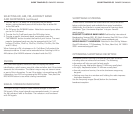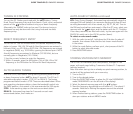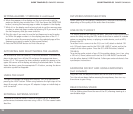
10
GLOBE TRAVELER G3 OWNER’S MANUAL
11
GLOBE TRAVELER G3 OWNER’S MANUAL
OPTIMIZING SHORTWAVE RECEPTION continued
TUNING SSB (Single Side Band)
TUNING SSB (Single Side Band) continued
USING THE DX/LOCAL SWITCH
USING THE SYNCHRONOUS DETECTOR
WIDE/NARROW SWITCH
BAND MEGAHERTZ (MHz) KILOHERTZ (KHz)
120 m 2.300-2.495 MHz 2300- 2495 KHz
90 m 3.20-3.40 MHz 3200- 3400 KHz
75 m 3.90-4.05 MHz 3900- 4050 KHz
60 m 4.750-5.1 MHz 4750- 5100 KHz
49 m 5.73-6.3 MHz 5730- 6300 KHz
41 m 6.89-7.60 MHz 6890-7600 KHz
31 m 9.25-9.95 MHz 9250-9995 KHz
25 m 11.5-12.2 MHz 11500-12200 KHz
22 m 13.57-13.87 MHz 13570-13870 KHz
19 m 15.005-15.825 MHz 15005-15825 KHz
16 m 17.48-17.9 MHz 17480-17900 KHz
15 m 18.9-19.02 MHz 18900-19020 KHz
13 m 21.45-21.85 MHz 21450-21850 KHz
11 m 25.67-26.1 MHz 25670-26100 KHz
SSB enables listening to shortwave two way communications using the
single-sideband mode such as amateur radio, Morse code, weather-fax
transmissions and other signals often referred to as ‘utility’ signals. The
Internet and your local library are great resources to learn more.
To experiment with SSB, turn on the G3 and position yourself near a
window if you’re in a building with stories above you. Tune to the 20
meter Amateur band, by pressing 14150 KHz with the keypad and then
pressing the AM button to enter it. Turn on the SSB circuit by pressing
the SSB button twice (don’t select SYNC). Note that SSB appears in the
display and USB or LSB are to the right. Select upper sideband (USB)
with sequential presses of the U/LSB button. Set the FINE tuning knob
to its approximate center position. Put the sensitivity switch, on the
left side of the radio, to the DX position. Fully extend the antenna and
with the tuning knob tune slowly from 14150 to 14350 KHz, listening
for anything that sounds like a human voice. Use the tuning knob to
coarse-tune the SSB signal, then ne-tune with the –FINE+ knob.
This SSB circuit allows tuning of both upper and lower sideband
signals. For best clarity of some extremely strong SSB signals, placing
the DX/LOCAL switch (left side panel) in the LOCAL position (down)
may be desirable.
The DX/LOCAL switch (left side panel) adjusts sensitivity. Use DX (up) as
the default setting for maximum sensitivity to signals. If strong stations
or SSB signals seem distorted, then use LOCAL (down). This switch does
not function in FM mode.
The synchronous detector can be used when listening to AM (medium
wave) and shortwave broadcast stations. It may help to minimize inter-
ference and to improve the signal quality. While listening to a station
press the SYNC button. SYNC appears in the display as does USB or LSB
to the right. You can sync on the Upper or Lower sideband by pressing
the U/LSB button and noting which selection gives the clearer reception
or improves the audio. Turn the synchronous detector off while tuning
stations or when it’s not needed. Using the WIDE/NARROW button may
also help. Using the synchronous detector does not always minimize
interference or improve the signal. To turn the synchronous detector off,
press the SYNC button.
This is a selectivity switch on the right side of the radio, under the TUNE
knob. Use WIDE when there is no adjacent frequency interference for
the best audio delity. Use NAR. To reduce adjacent frequency interfer-
ence, but minimizing audio delity.


















